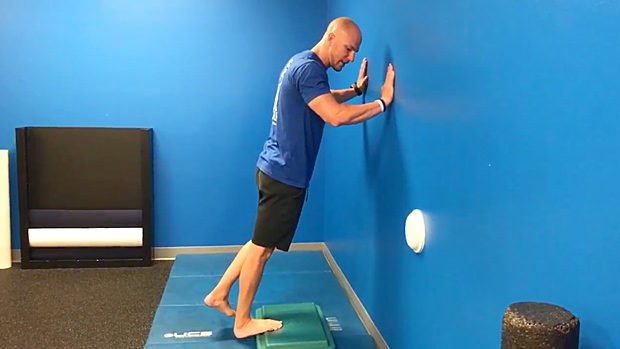The ankle is complex. It actually contains several joints that work together to move in all three cardinal planes of motion and also in multi-angled oblique planes of motion.
With the amount of anatomical movement variance that happens with each step, you'll need to categorize your type of ankle mobility restriction in a basic way. Based on the feel of a dorsiflexion terminal end range of motion, you can figure out if the restriction is a soft-tissue or joint-based issue.
- Do this test without shoes. You'll be looking at one ankle at a time.
- Step onto an elevated surface and place your foot onto the step keeping the ball of the foot in contact with the step and toes straight forward.
- Place all your weight into the ankle being tested. With a straight knee, drive your heel down towards the ground while the toes stay in contact with the step.
- You can move your body forward slightly to accentuate the stretched position of the ankle.
- When you can no longer increase ankle range of motion, hold this position for 5-10 seconds and assess the feel of the limitation: either a stretching sensation through the back of the leg (Achilles region) or a block at the front of the ankle.
- Test the same ankle now with a slightly bent knee position. Again, assess for a stretch through the back of the lower leg, or a block at the front.
An ankle (or any other articulating joint for that matter) can either be restricted via soft-tissue tone and tightness, or through a joint restriction. If a stretch is achieved through the backside of the lower leg in both positions, you are most likely dealing with a soft-tissue restriction.
If you feel a blocking sensation at the front side of your ankle during both knee-testing positions, you're most likely dealing with a joint mobility limitation. If you have discrepancies between straight and slightly bent knee positions where you feel the limitation, you'll be addressing both soft tissue and joint restrictions.
While soft-tissue restrictions can be addressed with foam rolling and stretching, a joint restriction can NOT be improved with these methods, and will most likely exacerbate the symptoms and range of motion limitations when these soft-tissue strategies are used on a joint mobility issue. And that's exactly why you test for the type of limitation you have.
For the next steps, see the first related link below.



